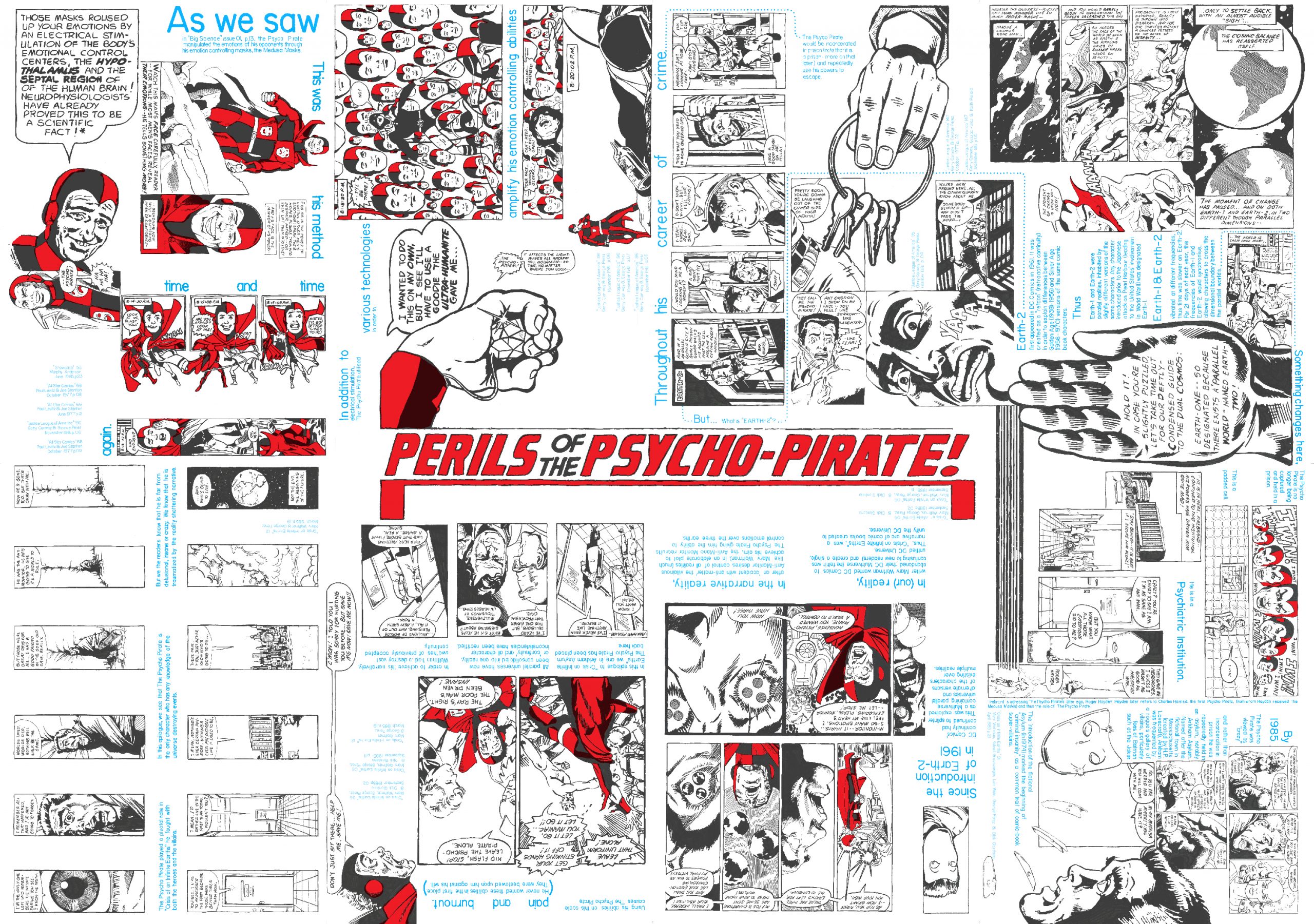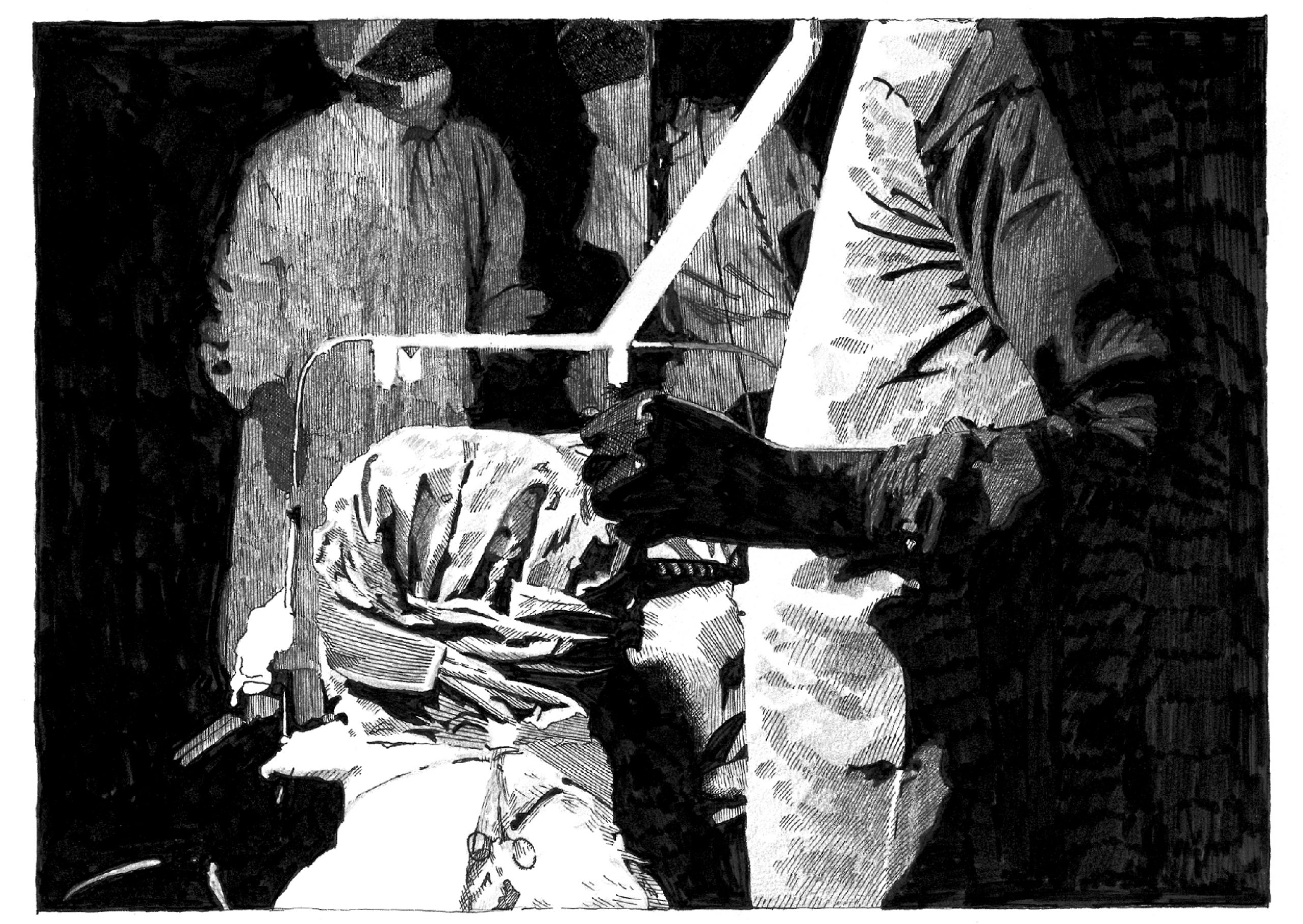Introduction
The definition of artistic activity occurs, first of all, in the field of distribution.
Marcel Broodthaers.[1]
In my ongoing project Big Science I explore dispersed, distributed, serialised and semi-improvised formats. The project tests the potential of serialised, dispersed distribution to question, or even reshape accepted socio-political histories and the forms with which they are conventionally recorded and archived. As Big Science continues I will experiment with intimate and radical technologies that have always been mobilised in information sharing: print and distribution.
Since 2016 I have been examining the archive of Dr. Carl Wilhelm Sem-Jacobsen (1912 -1991) who from 1956 – 1977 experimented on psychiatric patients of Gaustad Hospital, Oslo by implanting electrodes deep into various areas of their brains and applying electrical current. He established an Electroencephalograph (EEG) Research Laboratory at Gaustad with financial support from the Ford Foundation, the Rockefeller Foundation and the U.S. Military, Airforce, Navy and NASA. His experiments were conducted without the consent of patients or their families.
From this archival research into Sem-Jacobsen, I have experimented with outcomes as diverse as video, lecture / performance and most recently an ongoing, serialised, artist’s publication, Big Science.
With Big Science I intend to further develop a performative publishing practice in which this history is narratively archived and distributed, reframed by serialisation: by the intimacy of a hand drawn or manual print reproduction; a letter in the post; a poster in the street; a pamphlet copied and passed around between peers.
Project Anywhere will see the release of Big Science Issue # 05, which will be a series of street posters, distributed on the streets of various sites and available to be collected. The posters will examine the (various) intersections between Sem-Jacobsen and his work with and for the U.S. Military.
[1] In Price, Seth. 2008. Dispersion. (New York, NY: 38th Street Publishers).

Issue #01 p. 32 / Postcard 01, 2021. Ink and pencil drawing from archive of Dr. C. W. Sem-Jacobsen, Norsk Teknisk Museum, Oslo, 105 x 148 mm. © Martin White 2021 with permission from Norsk Teknisk Museum (please use as tile)
Methodology
Up until now, my experimental artistic outcomes have all focussed upon dispersed distribution, be it person to person as in a lecture, or through print technologies that deliberately avoid control and ownership. My artistic outcomes are not distributed through technologies owned by big tech, so even the publicity for the Big Science publication takes place largely offline e.g. through distribution of postcards.
In addressing difficult and often forgotten histories, I want to gently draw the audience into an increasingly complex story over an extended period of time. By the end they have been pulled and implicated into a vast, tangled web. For example in my lecture / performance Are We Not Drawn Onward, We FeW, drawn OnwarD to NeW erA (2017) I deliberately began very informally, including hesitations, stumbles and mistakes in order to establish trust, sympathy and be unassuming. By the end of the performance, I had revealed a highly theatrical structure that included sleight of hand and other theatrical techniques to draw the attention of the audience to my power and to question their trust in me as the mediator of this story.
Serialised media share this trait of public development of thematic material and narrative threads, what Fred Moten and Stefano Harney call ‘speculative practice’[1], a public, loitering, evolving, improvised practice.
Comics
In 1965, Sem-Jacobsen’s experiments were cited in a U.S. superhero comic book – testament to Sem-Jacobsen’s (self) promotion in North America (he was also cited in a 1963 LIFE Magazine). A villain, the Psycho-Pirate, controls the minds of his enemies by electrically stimulating specific areas of their brains. The panel in which an Editor’s note refers to “THE EXPERIMENTS OF DR. C.W. SEM-JACOBSEN OF NORWAY” appears as a photograph in Sem-Jacobsen’s archive. This image of an image allows us to see the editorial choices made by Sem-Jacobsen; selecting what is in his archive and how he wants to be remembered. This photograph of a comic panel first suggested the form of Big Science; a serialised ‘comic book’ printed from hand-drawn 1:1 drawn recreations of archival material, highlighting my own subjective editorial and narrative choices. The form of a comic book echoes both this reference in the archive and archives themselves; pages containing multiple images, text, layout and gaps between.
Comics exist on (at least) two layers of structure: the page (the surface appearance) and the panel (the underlying source). In comics (as in montage, or collage) a new ontology is formed between the component parts and the page as a whole. This is the narrative of comics (I would argue that this is true also in our reading of archives: a meaning is formed between the component that is archived and the ‘page’ as a whole, containing many components). Many comics artists have noted the medium’s unique ability to represent and manipulate spacetime, and the ways in which human memory neurologically functions.
Comics appear serially. The story-telling mechanism of serialisation allows a compression and expansion of narrative time. The breaks and pauses between issues encourage deep re-reading and cycling over the material again. The tension and release of narrative suspension and continuation is analogous to our experience of time.
I have also become interested in the larger print ecosystem surrounding commercial comics and how I could play with other print ephemera, such as posters, trading cards, stickers, or pamphlets. Comics artists such as Chris Ware utilise this dispersed distribution as a tool for world building and story-telling, where segments of a narrative will appear in a self-published volume, in a collection alongside other artists, as a newspaper strip, as a cover of a magazine. Ware’s Building Stories[2] collects diverse print media such as these into 14 discrete units that can be read in any order. They range from a facsimile of a children’s book, to a broadsheet newspaper. Similarly, Big Science Issue #02 was composed entirely of articles and letters, reproduced in their entirety, including their printed context, so that print advertisements are reproduced alongside the quoted article, but other articles are not – their lettering is abstractly represented. Some context is provided, but context is infinite, so some context is also withheld.
[1] Harney, Stefano, and Fred Moten. 2013. The Undercommons: Fugitive Planning and Black Study. (Wivenhoe, Minor Compositions) 110.
[2] Ware, Chris. 2012. Building Stories. (London: Jonathan Cape, Random House.)

Perils of the Psycho Pirate! Big Science Issue #04, 2022/2023. Ink drawings from found material, A1 fold out poster. © Martin White 2022 / 2023
Comics as a form is a well-established medium of contemporary art. Artists such as Öyvind Fahlström, the Situationist International (Asger Jorn) and Bazouka Collectif have explored the conceptual potential of comics as collages of page / panel / image / words. But commercial comics also has a history of documentary with artists such as Joe Sacco, Art Spiegelman and Marjane Satrapi making socio-political documentary comics work. As I discovered through my research in developing Big Science, in recent years comics have also been used as a tool in the discourse of health, illness, caregiving and disability with the Graphic Medicine movement, which is utilised to disrupt the power imbalance between doctors and patients in the representation of their illnesses. Graphic Medicine is now a rich and productive communication tool for both medical practitioners and medical patients.
In future issues of Big Science I will exploit the inherent discontinuity of time and space in the comics medium to represent the subjective experiences of the patients upon whom Sem-Jacobsen was experimenting. I will for example represent linear spacetime distortion by manipulating page order, left to right and top to bottom panel order, and issue order, represent auditory and visual hallucinations with for example printing registration or digital glitches and other printing artefacts.
Expanded comics, like the expanded field of print practice, offers exciting potentials not only for the vital representation of, but also for the distribution and dissemination of radical, political, disruptive or illicit material. It is (and has perhaps always been) a naïve container for subversive content.
Audience Complicity
In the lecture / performance Are We Not Drawn Onward, We FeW, drawn OnwarD to NeW erA (2017) I sought to build up complicity with the audience – to expose them to something that they legally shouldn’t be seeing; to build up this illicit, underground form of information sharing. Small-scale publishing can have this kind of complicity with its readers and exploring this potential will be an important part of the project. Echoing revolutionary political pamphlets, print media can activate a viewer as they handle, receive, share, collect and distribute an illicit publication.
In Big Science, I have utilised various mechanisms to activate the audience further: Issue #02 was only partially assembled, and included assembly instructions for the readers to put together themselves.

Issue #03, p. 71, 2023. Ink drawing of image from the archive of Dr. C. W. Sem-Jacobsen, Norsk Teknisk Museum, 105 x 148mm. © Martin White 2023 with permission from Norsk Teknisk Museum.




